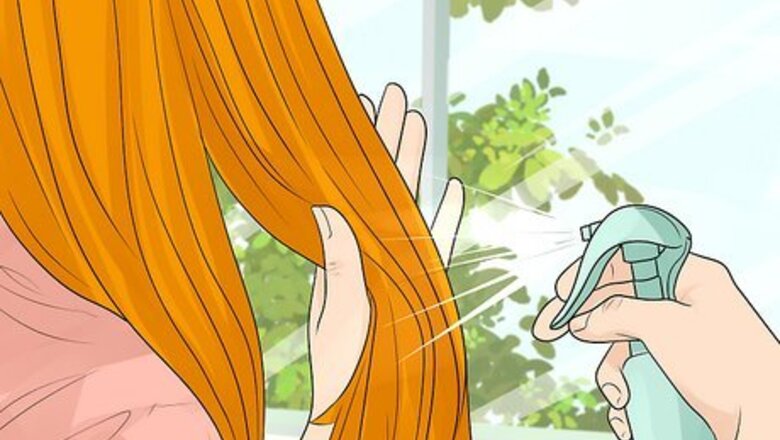
views
Cutting Even, Sectioned Layers
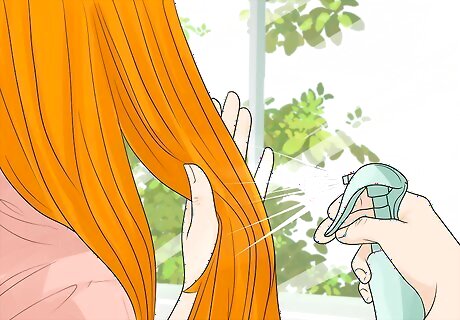
Dampen your hair. You can wash your hair with shampoo and conditioner if your hair is dirty. Then, wring out the excess moisture with your hands and squeeze your hair with a microfiber towel or t-shirt so it is just damp. You may also need to let your hair air dry until it is damp. If your hair is already clean and dry, fill a spray bottle with warm water. Spray your hair until it is damp.
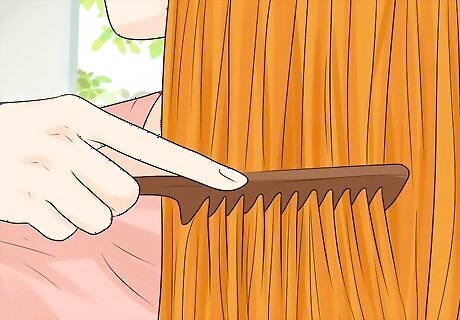
Detangle your hair with a comb. Use a fine tooth comb to detangle your hair—carefully remove snarls and knots from your locks. Start combing downwards near the ends of your hair and work your way up the hair shaft as you detangle it. If your hair dries while you are combing it, use a spray bottle filled with water to re-wet your locks.
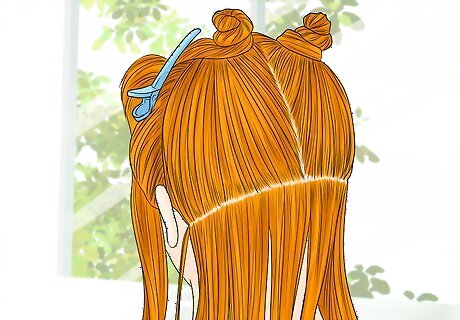
Divide your hair into 4 even sections. Part your hair down the center of your head—from the top of your forehead to the base of your skull. Part your hair horizontally twice—once at the top of your ears and once at the base of your ears. You now have 1 top section, 2 side sections, and 1 section at the base of your skull. Twist each section and secure it with a large hair clip. Make sure the right sections are even with the left sections, and that you have clean, precise parts dividing the sections.
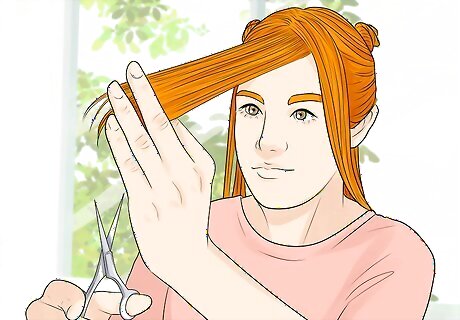
Create your first guide. Unclip the top section. Section off a small segment of the hair at the top of your forehead. This segment will be your first traveling guide. Determine the length of your first layer. Cut between 1 to 2 inches (2.5 to 5.1 cm) off your layers at a time—you can always go shorter! Insert your traveling guide between the forefinger and middle finger of your non-dominant hand. Slide the fingers towards the ends—pulling the segment at a 90° angle—until your fingers have reached the part you would like to cut off. Trim the excess hair with a pair of sharp shears. A traveling guide moves with the area being cut. The most recently cut segment of hair in a section assumes the role of the traveling guide. It is held up to the next segment of hair and used as a ruler.

Trim the remainder of the section. Use your travelling guide, the most recently cut segment of hair, to determine the length of the next segment. Slide the traveling guide and the next segment of hair between your forefinger and middle finger. Move the fingers towards the ends—pulling the hair at a 90° angle—until you reach the end of your traveling guide. Cut the new segment of hair so that it is the same length as the traveling guide. The freshly cut segment is now your travelling guide. Repeat the process until the entire section is cut. Check the evenness of your trim periodically. Pull the hair in multiple directions and at varying angles to check the evenness of the cut. For example, if you trimmed a section using a vertical part, then check the section using a horizontal part. Trim any uneven pieces before moving onto the next section of hair.
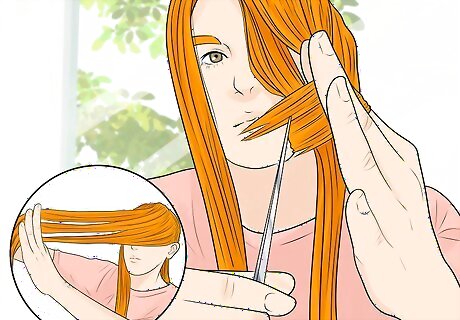
Cut the left section. Unclip the left section. Use the first layer as a guide to determine how much hair to trim off the second layer. Begin by cutting 1 to 2 inches (2.5 to 5.1 cm) off—take off more length as needed. Gather a small segment of hair at the front left side to use as your first guide. Pull the segment of hair straight at a 90° angle. Slide your fingers towards the ends of the hair until you reach the point you would like to cut off. Trim the excess hair. Cut the remainder of the section with the aid of your traveling guide.
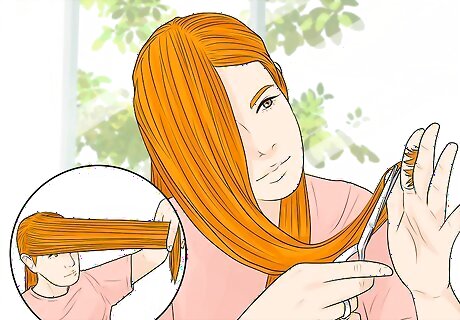
Cut the right section. Unclip the right section. Gather a small segment of hair at the front left side (your travelling guide) and the front right side. Insert the 2 segments between your middle and forefinger and pull them forward at a 90° angle. Stop your fingers at the end of the left segment. Trim the excess hair from the right segment. Cut the remainder of the section with the aid of your traveling guide. Check the evenness of your trim periodically. Pull the hair in multiple directions and at varying angles to check the evenness of the cut. Trim any uneven pieces before moving onto the next section of hair.
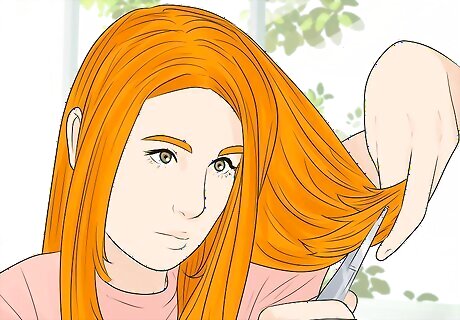
Trim the bottom section. Unclip the bottom section. Use the layers above to help you determine the length of your last and final layer. Start by trimming off 1 to 2 inches (2.5 to 5.1 cm) —take off more length as needed. Gather a small segment of hair at the center of your bottom section. Pull the segment of hair straight at a 90° angle. Slide your fingers towards the ends of the hair until you reach the point you would like to cut off. Trim the excess hair. Cut the remainder of the section with the aid of your traveling guide.
Cutting All-Over Shaggy Layers in Your Hair
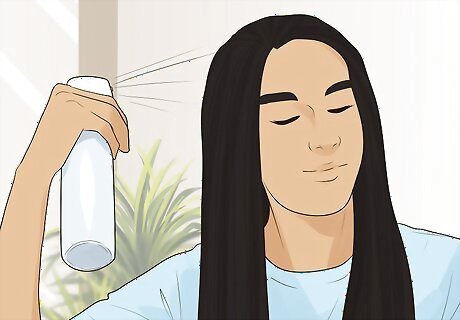
Prep your hair for the cut. Shampoo and condition your hair prior to cutting your locks. Squeeze the excess water from your tresses. Comb through your hair to remove all of the snags and snarls. Fill a spray bottle with warm water. As your hair dries, dampen your hair with the water from the spray bottle. You may also choose to forgo washing your hair and simply wet it with the spray bottle.
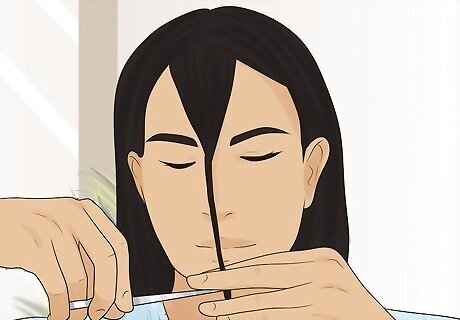
Cut your stationary guide. Throughout the haircut, you will use 1 stationary guide to cut every segment of hair. This will produce shaggy layers at varying lengths throughout your hair. Section off a small segment of hair at the top of your head. Determine the length of your stationary guide (the shortest layer). Grasp the stationary guide between the middle and forefinger of your non-dominant hand. Slide the fingers towards the ends while pulling the segment straight up at a 180° angle. Stop your fingers when they have reached the desired length. Trim the excess hair with sharp shears. Instead of cutting off too much hair, start gradually. Trim off 1 to 2 inches (2.5 to 5.1 cm) of hair from your stationary guide and complete the entire haircut. If your hair is too long, take another 1 to 2 inches off from your stationary guide and re-cut your hair.
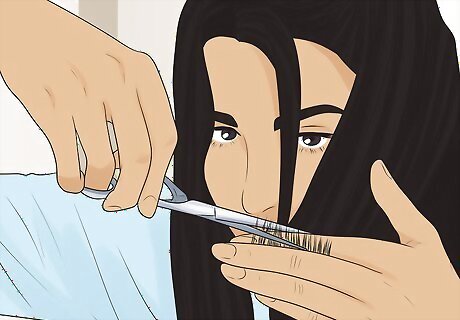
Cut the surrounding hair. Starting at the front of your head, insert a segment of hair surrounding the stationary guide and the stationary guide between your middle and forefinger. Slide your middle and forefinger towards the ends—pulling the hair at a 180° angle—until they reach the length of the stationary guide. Trim the excess hair. Repeat this process, working from front to back down the center of your head.
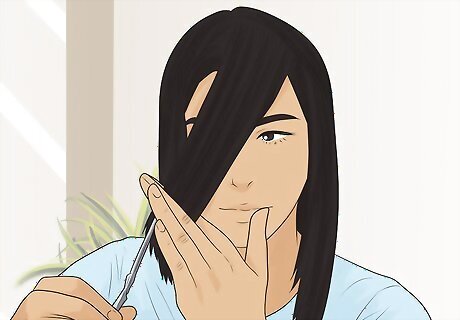
Trim the sides. To produce even layers, alternate between cutting segments on the left side and the right side. Insert a segment of hair and the stationary guide between your middle and forefinger. Slide your middle and forefinger towards the ends—pulling the hair at a 180° angle—until they reach the length of the stationary guide. Trim the excess hair. Repeat until all of your hair is cut.
Cutting Your Hair in a Ponytail
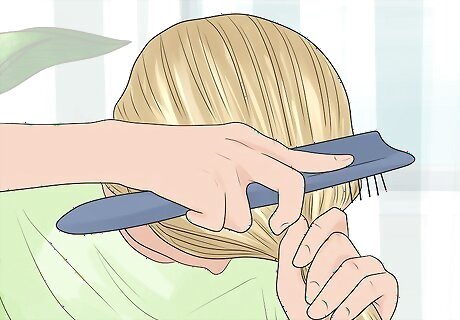
Prep your hair. Begin with dry, clean hair. Carefully brush your hair until it is smooth. Pay particular attention to removing any snarls or knots in your long locks.
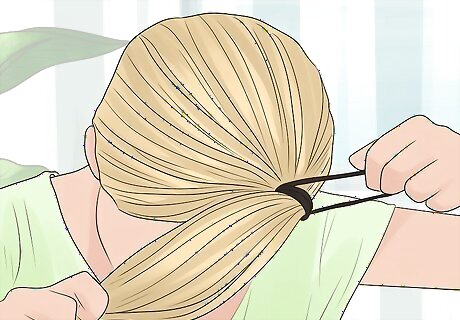
Brush your hair into a ponytail. Bend forward at your waist. Brush your hair forwards towards your forehead. Gather your hair into a ponytail at the base of your forehead. Secure it tightly with a rubber band. Imagine that you are transforming your hair into a unicorn’s horn. The ponytail should be located in the same place as a unicorn’s horn.
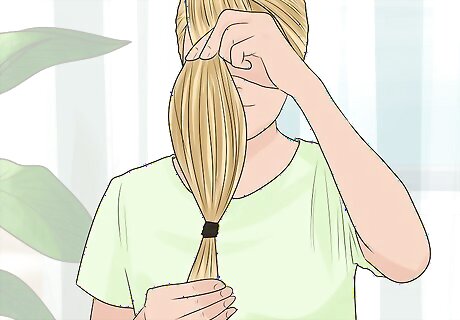
Position the rubber band. Remain bent over at your waist. Slowly slide your rubber band towards the ends of your hair. Stop 1 to 2 inches (2.5 to 5.1 cm) from the ends of your hair. Adjust the rubber band to the desired length—remember, it is always better to cut a little bit off at a time!
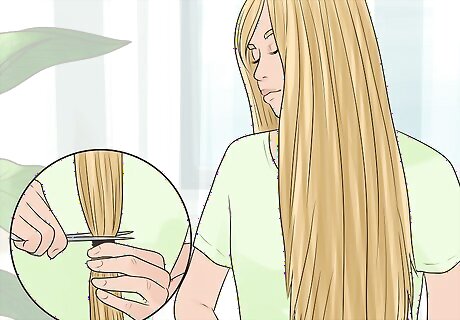
Cut your hair. Position your non-dominant hand securely over the rubberband. As you stand up straight, try not to shift your hair or the position of your hand. Using a pair of sharp shears, cut just below the rubber band. Set down the hair you cut off, remove the ponytail holder, and assess your layered look. If you want to cut more hair off, repeat the process. After you remove the ponytail holder, make sure to check you layers for evenness. If you notice any areas that are uneven, use a pair of scissors to clean them up. Be sure to look in a mirror as you do this.














Comments
0 comment